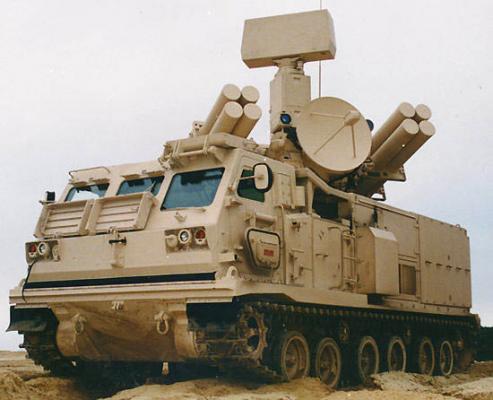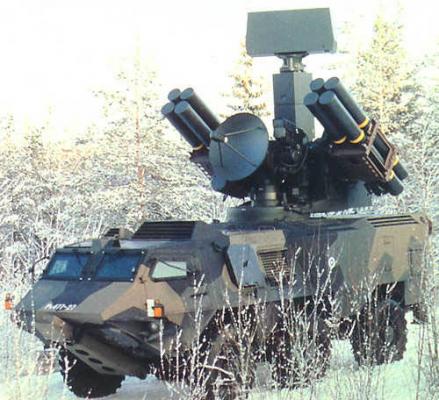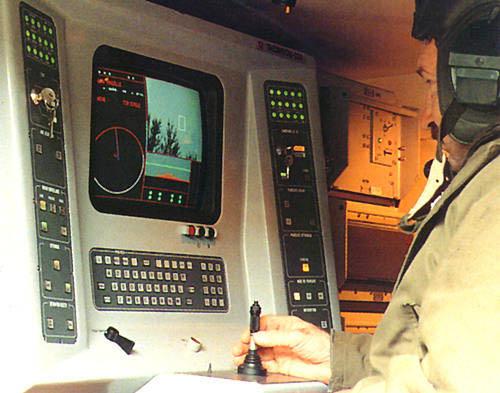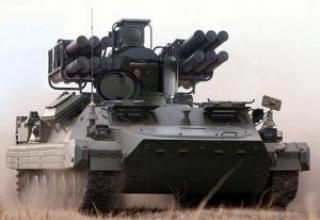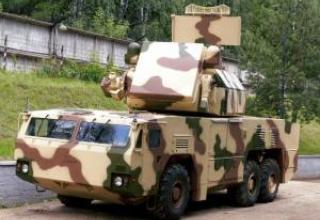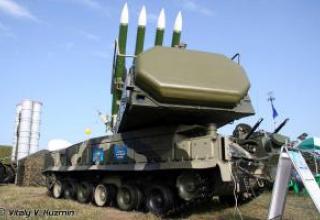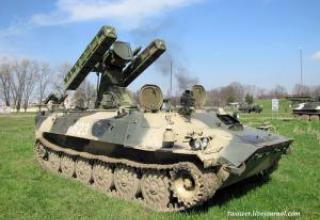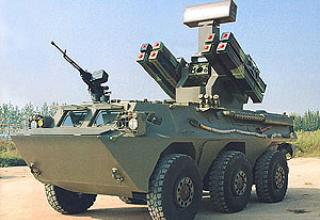French short-range anti-aircraft missile system Crotale - all-weather military air defense system of the first echelon units.
The complex exists in several modifications: the basic version of the Crotale, the ship complex - Crotale Naval, "Cactus" (exported to Chile and South Africa) and Shahine (exported to Saudi Arabia). The last variant of the complex is Crotale-NG, designed to provide air defense of troops and civilian objects, combat orders of tank and mechanized brigades.
The Crotale-NG complex uses a high-speed VT-1 missile developed by the U.S. firm LTV and French Thomson-CSF for the U.S. Army under the Faad program. According to Thomson-CSF representatives, Crotale-NG SAM system is a response to the recently introduced aviation equipment, which allows aircraft with a fixed wing to attack at any time of day and in any weather, and helicopters to perform unexpected attacks, using the tactics of sudden appearance due to natural hiding places.
The complex is in production. Mass production of the VT-1 missile began in mid-1989. The first serial VT-1 came into service in 1990. It is in service with France (Air Force - 12 air transportable firing units of container type), Finland (ground forces - 20 complexes on the chassis of Sisu XA-180, Greece, the Netherlands. South Korea has several chassis purchased to upgrade its own Pegasus air defense system.
The last variant of modernization of the complex was designated as Crotale Mk.3. Crotale Mk.3 is equipped with an improved missile with a range up to 16 km and a new multi-beam radar detection Shikra 3D by Thales.
Composition:
Although the Crotale-NG SAM is a new system, it is based on a number of improved components of the previously developed complex. For example, the PU is based on Thomson-CSF's experience in developing a large family of Crotale SAMs. Electrically rotating turret complex Crotale -NG weighing about 4800 kg includes a surveillance radar with built-in state identification request, radar escort, optical equipment consisting of infrared, working day and night, camera, infrared rangefinder, daytime TV camera and eight combat-ready missiles, placed two packages of four missiles each. The complex can be placed on one tracked or wheeled platform. Possible carriers of the complex are the chassis of the tank AMX-30V, APC M113, KIFV and Puma, as well as - BMP Bradley (shelf version).
The TRS2630 E-band radar with frequency converter rotates at 40 rpm. It is equipped with a flat antenna and has improved noise immunity (low side lobes, beam strobing, wide frequency switching and constant false alarms) and is able to operate when the chassis is moving. The detection range of the aircraft is 20,000 m and about 8,000 m for dependent helicopters. The maximum detection altitude is 5000 m. The radar can search in a precisely confined sector, and can simultaneously escort the eight most dangerous targets.
Escort radar - monopulse Doppler with frequency conversion and improved noise immunity station, which operates in the J-band with a range of 30,000 m for targets such as helicopters and aircraft with a speed above M2.
Opto-electronic target tracking system includes the Castrol Thermal TV camera, which has a wide (8.1 ° x 5.5 °) and narrow (2.7 ° x 1.8 °) field of view (maximum detection range in good weather conditions is 19000 m and reduced to 10,000 m in poor visibility conditions), daytime television camera type Mascot CCD TV camera with a field of view 2. 4° x 1.8° and a target detection range of up to 15000 m, a video tracking system channel for automatic tracking of the target and the missile, as well as an IR long-range camera with a wide field of view to capture the missile at its initial flight.
In pointing the missile, the data received by all the measuring systems are used and transmitted on board the missile. Under normal conditions, radar and optical-electronic systems operate simultaneously and constantly monitor each other. Tracking systems determine the area of view (observation window) where the target is located, the location of the guided missile and the location of decoys. Within this coverage area, windows are calculated for each accompanied target. The coordinates obtained from the various meters (radar channel and optical) for each target are compared using a digital filter. Later on, a more accurate estimate of the coordinates of the target and the missile is used. All control commands for the missile are transmitted using a narrow beam (frequency tuning in the remote control channel is used).
Colour screens of the monitors display target numbers, thermal and television images, as well as video information from the tracking radars, a large-scale grid of the overview radar and information about the readiness for missile launch. Crotale-NG complex is a fully autonomous system in which the process of detection, target acquisition for escort and destruction is automatic. The shooter needs only twice to conduct state identification of the target. Due to the high level of automation, the complex has a reaction time of 5 seconds. The total time required to destroy a target flying at a speed of 300 m/s and the captured radar at a range of 13 km is about 15 seconds. The recapture time is 1-2 s and depends on whether the target is a group target or a single target. It is theoretically possible to destroy two separate groups of 4 targets each at full depth of the kill zone with one fire unit. The reload time of the two missile packets is about 10 minutes. The fire control system of the complex makes it possible to integrate it into complex air defense systems. The battery of 4 launchers can operate in a coordinated mode, providing automatic data exchange in order to select the best option for action to hit the target.
The radio interfering device has undergone virtually no changes. Both in escort and pointing modes, the radar uses a jump frequency switch from pulse to pulse and from packet to packet. In the course of the missile flight, the receiver-transmitter operates in the mode of high maneuverability by frequency and compression of pulses.
The VT-1 (Vought-Thomson) missile was developed by LTV under a contract with Thomson-CSF (beginning of development - 1986), has a radio command /electronic-optical guidance system. Maximum guidance range of the missile is 10 km, high maneuverability (35g) and speed - 3.5M can intercept maneuvering targets at a range of 8 km for about 10 seconds.
The VT-1 LSD contains :
- head end, where are: non-contact radio and contact fuse, battery, guidance system equipment, electronic data processing equipment;
- a 14-kg shrapnel BC of directional action. The BC VT-1 contains pre-fragmented fragments, which in the case of an explosion have a directional effect and are particularly effective for small targets. The electromagnetic fuse operates with a delay time ranging from 0.2-0.5 s to the point where it meets the target. The radius of engagement of a combat unit is about 8 m. The electromagnetic fuse can be operated with a delay time of 0.2-0.5 s to the point where it meets the target.
- The central compartment where the RDTT is located with a powder charge, which uses low smoke fuel;
- Tail compartment with folding stabilizers, control unit (gas, high pressure) and transceiver.
The RDTT is an upgraded version of the Sidewinder air-to-air solid propellant rocket engine. The engine weighs 37.9 kg and contains 31.4 kg of fuel. The engine charge fuel includes polybutadiene with a final hydroxyl group. The RDTT casing is made of epoxy graphitoplastic. The missile's flight is stabilized by four folding steel stabilizers that open after its flight from the TIC.
Characteristics:
| Range of fire, km | 0.5-10 |
| Defeat height, km | 0.015 - 6 |
| Maximum target speed, m/sec. | 500 |
| Number of simultaneously fired targets | 1 |
| Productivity, sharp targets/min. | 3-4 |
| Target detection range with EPR=1m2, km | 20 |
| Escort range of the target, km: - radar channel (EPR=1m2) - optical channel |
16 15 |
| Number of missiles on the PU, pcs. | 8 |
| The reaction time, sec | 5 |
| Maximum missile flight speed, m/sec. | 1247 (3.5M) |
| The average flight speed of the rocket at a range of 10 km, m/sec | 710 |
| Flight time at a range of 8 km, s | 10 |
| Missile launch weight, kg | 73 |
| Type of combat unit | directional shrapnel |
| Weight of combat unit, kg | 14 |
| Missile guidance system : | radar or optical direction finding |
| Available overload, g | 35 |
| The dimensions of the rocket, mm: - length - diameter |
2290 165 |
Testing:
The first combat use of the S-200 SAM system took place in 1982 in Syria, where at a distance of 190 km the E-2C "Hawkeye" DRLO was shot down, after which the American aircraft carrier fleet withdrew from the Lebanese coast. The Libyan S-200 complexes took part in repulsing an attack by American FB-111 bombers and possibly shot down one bomber.
On the basis of the 5B28 anti-aircraft missile of the S-200B complex a hypersonic flying laboratory "Cold" has been created to test hypersonic direct-flow air jet engines. The choice of this missile was based on the fact that the parameters of its flight path were close to those required for flight tests of the Hyper-Sonic Propulsion System. It was also considered important that the missile had been decommissioned and its cost was low. The missile's combat unit was replaced by the head compartments of the GLL "Kholod", which housed the flight control system, a liquid hydrogen tank with displacement system, a hydrogen flow control system with measuring devices and, finally, the experimental HPVRD E-57 of axially symmetric configuration.
Sources:
- http://www.army-technology.com
- Василин Н.Я., Гуринович А.Л. "Зенитные ракетные комплексы" .-Мн.: ООО "Попурри", 2002- 464с.
